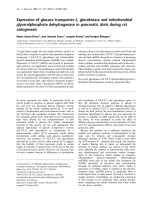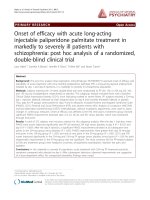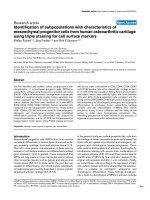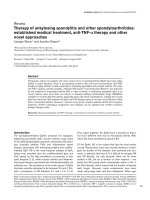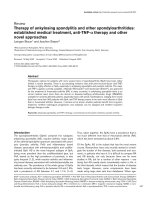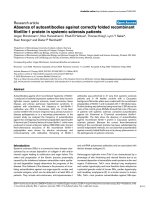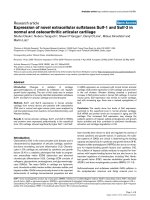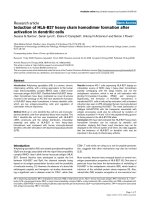Báo cáo y học: "Onset of efficacy with acute long-acting injectable paliperidone palmitate treatment in markedly to severely ill patients with schizophrenia: post hoc analysis of a randomized, double-blind clinical trial" doc
Bạn đang xem bản rút gọn của tài liệu. Xem và tải ngay bản đầy đủ của tài liệu tại đây (317.89 KB, 10 trang )
PRIMARY RESEARCH Open Access
Onset of efficacy with acute long-acting
injectable paliperidone palmitate treatment in
markedly to severely ill patients with
schizophrenia: post hoc analysis of a randomized,
double-blind clinical trial
Larry Alphs
1*
, Cynthia A Bossie
1
, Jennifer K Sliwa
1
, Yi-Wen Ma
2
and Norris Turner
1
Abstract
Background: This post hoc analysis (trial registration: ClinicalTrials.gov NCT00590577) assessed onset of efficacy and
tolerability of acute treatment with once-monthly paliperidone palmitate (PP), a long-acting atypical antipsychotic
initiated by day 1 and day 8 injections, in a markedly to severely ill schizophrenia population.
Methods: Subjects entering the 13-week, double-blind trial were randomized to PP (39, 156, or 234 mg [25, 100,
and 150 mg eq of paliperidone, respectively]) or placebo. This subgroup analysis included those with a baseline
Clinical Global Impressions-Severity (CGI-S) score indicating marked to severe illness. PP subjects received a 234-mg
day 1 injection (deltoid), followed by their assigned dose on day 8 and monthly thereafter (deltoid or gluteal).
Thus, data for PP groups were pooled for days 4 and 8. Measures included Positive and Negative Syndrome Scale
(PANSS), CGI-S, Personal and Social Performance (PSP), and adverse events (AEs). Analysis of covariance (ANCOVA)
and last-observation-carried-forward (LOCF) methodologies, without multiplicity adjustments, were used to assess
changes in continuous measures. Onset of efficacy was defined as the first time point a treatment group sho wed
significant PANSS improvement (assessed days 4, 8, 22, 36, 64, and 92) versus placebo, wh ich was maintained
through end point.
Results: A total of 312 subjects met inclusion criterion for this subgroup analysis. After the day 1 injection, mean
PANSS total scores improved significantly with PP (all received 234 mg) versus placebo at day 4 ( P = 0.012) and
day 8 (P = 0.007). After the day 8 injection, a significant PANSS improvement persisted at all subsequent time
points in the 234-mg group versus placebo (P < 0.05). PANSS improvements were greater from day 36 through
end point in the 156-mg group (P < 0.05) and only at end point in the 39-mg group (P < 0.05). CGI-S and PSP
scores improved significantly in the 234-mg and 156-mg PP groups versus placebo at end point (P < 0.05 for both,
respectively); improvement in the 39-mg group was not significant. The most common AEs for PP-treated subjects
(≥10%, any treatment group) were headache, insomnia, schizophrenia exacerbation, injection site pain, and
agitation.
Conclusions: In this markedly to severely ill population, acute treatment with 234 mg PP improved psychotic
symptoms compared with placebo by day 4. After subsequent injections, observed improvements are suggestive
of a dose-dependent effect. No unexpected tolerability findings were noted.
* Correspondence:
1
Ortho-McNeil Janssen Scientific Affairs, LLC, Titusville, NJ, USA
Full list of author information is available at the end of the article
Alphs et al. Annals of General Psychiatry 2011, 10:12
/>© 2011 Alphs et al; licensee BioMed Central Ltd. This is an Open Access article distributed under the terms of the Creative Commons
Attribution License ( w hich permits unrestr icted use, distribution, and reproduction in
any medium, provide d the original work is properly cited.
Background
Rapid symptom control in patients with schizophrenia
represents an immediate treatment goal, particularly for
those who are markedly or severely ill, because acute
symptoms are associated with emotional distress, dis-
ruptions to the patient’s life, and the risk of dangerous
behaviors [1]. Knowing when to expect a response with
a g iven antipsychotic is an important clinical cons ider a-
tion in managing these patients. Current data suggest
that, although it may take several weeks to achieve full
therapeutic effect with an antipsychotic, most of the
improvement in psychotic sympt oms is often seen
within 2 w eeks, with an onset of action within the first
few days [2-4]. It has also been report ed that early anti-
psychotic response may be indicative of subsequent
response in patients with schizophrenia [5].
Achieving an adequate response can be hindered by
non-adherence to the treatment regimen, a significant
problem in managing patients with schizophrenia [6-8].
Non-adherence within the first days of treatment, which
has been reported in nearly one-quarter of patients [9],
can impede the onset of e fficacy. The use of long-acting
injectable antipsychotics obviates the need to take daily
medication and may help to improve adherence [1,10].
Reports indicate that long-acting injectable antipsy-
chotics differ with respect to their onset of action.
Although it is difficult to compare onset data across stu-
dies for the various agents because of the vastly different
study designs and populations, there are reports that
suggest efficacy can occur as early as within the first few
days of treatment [11-14].
Paliperidone palmitate is the palmitate ester of paliperi-
done [15]. This atypical antipsychotic is a NanoCrystal
®
( />nology) suspension o f p aliperidone palmitate in an aqueous
formulation, which is given once monthly by injection (del-
toid or gluteal) after a recommended initiation regimen of
234 mg on day 1 and 156 mg on day 8 (both administered
in t he deltoid) [15,16]. This formulation was designed to
rapidly att ain therapeutic blood levels [15]. Several con-
trolled clinical studies have confirmed that paliperidone pal-
mitate is effective in controlling s ymptoms [17-19] and
delays time to relapse in patients with schizophrenia [20]
without the use of oral antipsychotic supplementation .
This post hoc analysis evaluated the o nset of efficacy
of acute treatment with paliper idone palmitate and dose
effect in markedly to sev erely ill subjects with schizo-
phrenia over 13 weeks of tre atment. Tolerability mea-
sures also were evaluated.
Methods
This was a po st hoc a nalysis of a 13-week, randomized,
double-blind, placebo-controlled, multicenter study of
three paliperidone palmitate fixed doses in subjects with
schizophrenia ( ClinicalTrials.gov: NCT00590577; study
ID: CRO12550). Methods for the overall study have pre-
viously been reported in detail [19].
The overall study was conducted in accordance with
the ethical principles th athavetheirorigininthe
Declaratio n of Helsinki and that are consistent with good
clinical practice and applicable regulatory requirements.
The original study protocol was reviewed and approved
by an independent ethics committee or an institutional
review board at ea ch study s ite, and all subjects prov ided
written informed consent before entering the study.
Subjects
Subjects who were at least 18 years of age were eligible for
study enrollment if they had a diagnosis of schizophrenia
per the Diagnostic and Statistical Manual of Mental Dis-
orders, 4 th edition (DSM-IV)[21],establishedatleast
1 year before screening, and if they had a Positive and
Negative Syndrome Scale (PANSS) [22] total score of at
least 70 at screening and between 60 and 120, inclusive, at
baseline [19]. The criterion for inclusion in this subgroup
analysis was a Clinical Global Impressions-Severity (CGI-
S) [23] score ≥5 at baseline (markedly to severely ill).
Study medication
In this report, dosing of paliperidone palmitate is
expressed as milligrams. P aliperidone palmitate dosing
also may be expr essed as milligram equivalents (mg eq)
of paliperidone. Paliperidone palmitate doses of 39, 78,
117, 156, and 234 mg are equival ent to 25, 50, 75, 100,
and 150 mg eq of paliperidone, respectively [15].
Study design and randomization
Thereweretwostudyperiods:ascreeningperiodofup
to 7 days for washout of d isallowed psychotro pic medi-
cations and a 13-week double-blind, f ixed-dose treat-
ment period. Subjects were randomly assigned (on a
1:1:1:1 basis) to fixed doses of paliperidone p almitate
(39, 156, or 234 mg) or placebo.
On day 1 of the study, all subjects received a deltoid
injection of paliperidone palmitate 234 mg or matching
placebo. Subjects were required to remain on their pre-
vious antipsychotic medication until the day before the
first injection of paliperidone palmitate or placebo. On
day 8 and monthly thereafter on days 36 and 64,
subjects received their assigned treatment per the rando-
mization schedule, injectedinthedeltoidorgluteal
muscle at the investigator’s discretion. Oral antipsycho-
tic supplementation was not permitted.
Inpatient hospitalization
Subjects could be voluntarily hospitalized during the
screening period at the investigator’s discretion. Subjects
were required to be hospitalized from the day of the
Alphs et al. Annals of General Psychiatry 2011, 10:12
/>Page 2 of 10
first injection on day 1 until at least after the second
injection of the study drug on day 8.
Study assessments
The primary efficacy measure was the change in the
PANSS [22] total score from baseline to each time
point (days 4, 8, 22, 36, 64, and 92) and end point.
Onset of efficacy was defined as the first time point at
which a given treatment group showed significant
PANSS improvement over p lacebo and maintained sig-
nificant improvement until end point. Other measures
were changes in CGI-S [23] and Personal and Social
Performance (PSP) [24] scores from baseline to end
point. Safety assessments included the recording and
monitoring of treatment-emergent adverse events
(AEs) and laborator y tests. Additionally, subjects were
assessed for movement disorders with the Simpson-
Angus Scale (SAS) [25], Barnes Akathisia Rating Scale
(BARS) [2 6], and Abnormal Involuntary Movement
Scale (AIMS) [27].
Analysis set
In this post hoc analysis, all efficacy and safety analyses
were performed on the intent-to-treat (ITT) analysis set,
which included a ll randomized subjects who received at
least one dose of double-blind study medication and
had both baseline and at least one post-baseline efficacy
assessment.
Statistical analysis
Analyses compared the three paliperidone palmitate
groups (note that per the study design the paliperidone
palmitate groups were pooled for days 4 and 8) with the
placebo group a t baseline at each time point ( including
end point), using the ITT analysis set. Mean (SD), med-
ian, minimum, and maximum were used for summary
of continuous variables; percentage and frequency were
used for categorical variables. Between-treatment-group
diff erences in continu ous variables were evaluated using
an analysis of covariance (ANCOVA) model, with treat-
ment and country as factors and baseline score as a cov-
ariate. Changes from base line are presented as least-
squares (LS) means and standard errors (SEs). Change
from baseline in PANSS total score was further evalu-
ated for all subjects using a mixed model with time,
country, treatment, and treatment-by-time interaction as
factors and baseline value as a covariate. An unstruc-
tured variance-covariance matrix was employed for this
analysis. Between-treatment-group differences in benzo-
diazepine use and response rates were evaluated using
the Cochran-Mantel-Haenszel test, controlling for coun-
try. LS mean changes from baseline to end point and
their 95% confidence intervals for effect sizes of treat-
ment versus placebo were calculated using Cohen’ s d
methodology, and between-group differences were eval-
uated using the ANCOVA model described above. All
statistical tests were two sided, and no adjustments were
made for multiplicity. Last-observation-carried-forward
(LOCF) methodology was used.
Results
Baseline demographic and clinical characteristics
Of the 652 subjects in the original study, 312 (47.9%)
had marked to severe baseline illness as defined by the
CGI-S scale. Amon g these subjects, 88.1% had CGI-S
ratings of marked illness and 11.9% had severe illness.
Baseline demographic and clinical characteristics
appeared similar between the thre e paliperidone palmi-
tate groups and the placebo group (Table 1). With the
exception of the P ANSS total score and baseline CGI-S
score, baseline demographics and clinica l characteristics
were similar to those of the overall study population.
The mean (SD) PANSS total score at baseline was 87.1
(11.2) for the overall population versus 94.7 (8.9) for the
markedly to severely ill population.
Subject disposition
Completion rates were 38.6% of the placebo group and
48.6%, 50.0%, and 50.6% of the 39-mg, 156-mg, and
234-mg paliperidone palmitate groups, respectively
(Tabl e 1). The most common reasons for treatment dis-
continuation were lack of efficacy in the placebo
(28.9%), paliperidone palmitate 39-mg (22.2%) , and pali-
peridone palmitate 156-mg (19.4%) groups and withdra -
wal of consent in the paliperidone palmitate 234-mg
group (24.7%).
Benzodiazepine use
Proportions of subjects who used benzodiazepines dur-
ing the study were 63.9% in the placebo group and
69.4%, 66.7%, and 64.7% in the palipe ridone palmitate
39-mg, 156-mg, and 234-mg groups, respectively. No
significant differences were observed between the treat-
ment groups versus placebo in benzodiazepine use.
Efficacy
After the day 1 injection, LS mean PANSS total scores
improved significantly with paliperidone palmitate (all
received 234 mg) versus placebo at day 4 (P = 0.0 12)
and d ay 8 (P = 0.007) (Figure 1). After the day 8 injec-
tion of the assigned dose, a significant PANSS improve-
ment was seen at all subsequent time points in the
234-mg group versus placebo (P < 0.05). PANSS
improvement versus placebo was greater from day 36
through end point in the 156-mg group (P < 0.05) and
only at end point in the 39-mg group (P < 0.05) (Table
2). LS mean (SE) CGI-S and PSP scores improved signif-
icantly by day 36 (-1.4 [0.2] and 14.4 [1.9], respectively)
Alphs et al. Annals of General Psychiatry 2011, 10:12
/>Page 3 of 10
in the 234-mg paliperidone palmitate group (P <0.05)
versus placebo. LS mean (SE) CGI-S scores were
improved significantly at d ay 36 and at end point, and
LS mean (SE) PSP scores improved significantly at end
point for the 156-mg paliperidone palmitate group ver-
sus placebo (P < 0.05). Improvement in CGI-S and PSP
scores in the 39-mg group did not reach significance at
any tim e point. Corresponding effect sizes for paliperi-
done palmitate versus placebo at end point for the
PANS S (Figure 2), CGI-S ( Figure 3), and PSP (Figure 4)
showed similar results.
Results w ere similar using the mixed-model repeated
measures analysis of the PANSS total score (overall LS
mean (SE) treatment difference versus placebo: 39-mg
treatment group -4.0 (1.9), P = 0.034; 156-mg treatment
group, -6.5 (1.9), P < 0.001; 234-mg treatment group,
-6.4 (1.8), P < 0.001). The percentage of subjects who
achieved a response at end point was 15.7% in the pla-
cebo group and 36.1% (P = 0.014 versus placebo), 34.7%
(P = 0.026), and 41.2% (P < 0.001) for the 39-mg, 156-
mg, and 234-mg paliperidone palmitate groups,
respectively.
Safety
Reported AEs, discontinuations due to AEs, and extra-
pyramidal symptom (EPS)-related AEs are shown in
Table 3. The most common AEs in paliperidone palmi-
tate-treated subjects (≥10% in any treatment group)
were headache, insomnia, schizophrenia exacerbation,
injection site pain, and agitation.
Table 1 Baseline demographic and clinical characteristics
Baseline demographics/patient characteristics Placebo,
n=83
Paliperidone palmitate
234/39 mg, n = 72 234/156 mg, n = 72 234/234 mg, n = 85
Age in years, mean (SD) 40.3 (11.2) 40.1 (10.2) 38.4 (10.6) 39.0 (11.0)
Sex, n (%)
Male 56 (67.5) 50 (69.4) 47 (65.3) 60 (70.6)
Female 27 (32.5) 22 (30.6) 25 (34.7) 25 (29.4)
Race, n (%)
Caucasian 39 (47.0) 40 (55.6) 35 (48.6) 40 (47.1)
African American 36 (43.4) 24 (33.3) 26 (36.1) 35 (41.2)
Asian 8 (9.6) 5 (6.9) 10 (13.9) 6 (7.1)
Other 0 (0) 3 (4.2) 1 (1.4) 4 (4.7)
Age at diagnosis in years, mean (SD) 24.9 (8.1) 24.2 (6.8) 25.8 (8.7) 24.3 (8.0)
Baseline PANSS total score, mean (SD) 92.6 (9.2) 95.8 (8.9) 94.5 (7.9) 96.0 (9.2)
Baseline CGI-S score, n (%)
Marked (= 5) 73 (88.0) 60 (83.3) 68 (94.4) 74 (87.1)
Severe (≥6) 10 (12.1) 12 (16.7) 4 (5.6) 11 (12.9)
Prior hospitalization for psychosis, n (%)
None 5 (6.0) 5 (6.9) 6 (8.3) 7 (8.2)
1 19 (22.9) 10 (13.9) 9 (12.5) 11 (12.9)
2 16 (19.3) 13 (18.1) 18 (25.0) 17 (20.0)
3 9 (10.8) 12 (16.7) 13 (18.1) 12 (14.1)
≥4 34 (41.0) 32 (44.4) 26 (36.1) 38 (44.7)
Disposition
Completed, n (%) 32 (38.6) 35 (48.6) 36 (50.0) 43 (50.6)
Discontinued, n (%) 51 (61.5) 37 (51.4) 36 (50.0) 42 (49.4)
Reasons for discontinuation
Lack of efficacy 24 (28.9) 16 (22.2) 14 (19.4) 14 (16.5)
Withdrew consent 14 (16.9) 10 (13.9) 11 (15.3) 21 (24.7)
Adverse event 7 (8.4) 6 (8.3) 7 (9.7) 5 (5.9)
Lost to follow-up 4 (4.8) 5 (6.9) 3 (4.2) 1 (1.2)
Other 2 (2.4) 0 (0) 1 (1.4) 1 (1.2)
Each paliperidone palmitate subject received 234 mg of paliperidone palmitate on day 1 and then their assigned dose day 8 and monthly thereafter.
CGI-S = Clinical Global Impression-Severity scale; PANSS = Positive and Negative Syndrome Scale.
Alphs et al. Annals of General Psychiatry 2011, 10:12
/>Page 4 of 10
Mean SAS, BARS, and AIMS scores were low (≤1) in
all groups at baseline and end point. No significant dif-
ferences for paliperidone palmitate groups versus pla-
cebo were observed in the mean change from baseline
to end point score for these movement disorder rating
scales.
The LS mean (SE) weight change (kg) from baseline to
end point was 0.4 (0.7) in the placebo group versus 0.7
(0.6) in the paliperidone palmitat e 39-mg group (P =
0.652), 0.8 (0.7) in the 156-mg group (P = 0.513), and 1.1
(0.7) in the 234-mg group (P = 0.269). No significant
between-group differences were observed for the change
from baseline to end point in triglyceride, high-density
lipoprotein, or low-density lipoprotein levels for
paliperidone palmitate versus placebo. Small but signifi-
cant differences were observed in LS mean (SE) change
from baseline to end point in plasma glucose levels
(mmol/l) between placebo (-0.31 [0 .17]) and the 39-mg
(0.05 [0.16]; P = 0.033) and 156-mg (0.02 [0.16]; P = 0.049)
paliperidone palmitate dose groups; the difference between
the placebo group and the 234-mg paliperidone palmitate
group was not significant (-0.13 [0.2]; P = 0.253).
Prolactin levels increased significantly with paliperi-
done palmitate versus p lacebo in males and females in
all dose groups (P ≤0.001, Table 4). In the markedly to
severely ill population, one subject in the paliperidone
palmitate 39-mg group had an AE potentially related to
prolactin (ejaculation disorder).
< 0.05, 39-m
g
paliperidone palmitate versus placebo.
< 0.05, 156-mg paliperidone palmitate versus placebo.
< 0.05, 234-mg paliperidone palmitate versus placebo.
–25
–20
–15
–10
–5
0
L
S
Mean
(S
E
)
C
hange From Baseline
Placebo
Paliperidone Palmitate: 234/39 mg
Paliperidone Palmitate: 234/156 mg
Paliperidone Palmitate: 234/234 mg
Day 4
Day 8
Day 22
Day 36
Day 64
End poin
t
a
a
a
a, b
a, b
a, b, c
a
b
c
P
P
P
Figure 1 Least-squares (LS) mean Positive and Negati ve Syndrome Scale (PANSS) tota l score change from baseli ne for the
paliperidone palmitate dose groups versus placebo group (last-observation-carried-forward [LOCF] analysis). All paliperidone palmitate-
treated subjects received paliperidone palmitate 234 mg on day 1 and then received their assigned treatment on days 8, 36, and 64. SE =
standard error.
Alphs et al. Annals of General Psychiatry 2011, 10:12
/>Page 5 of 10
Discussion
This subgroup analysis of patients with moderate to
severe schizophrenia showed that acute treatment with
long-acting paliperidone palmitate, compared with pla-
cebo, improved symptoms as early as day 4 (the first
post-baseline time point), with improvement continuing
at day 8. Thus, these findings support rapid symptom
control after a day 1 deltoid injection of paliperidone
palmitate 234 mg in these patients. The demonstrated
onset of response within a week of initiating tr eatment
with long-acting paliperidone palmitate is consistent
with that documented with a number of other
Table 2 Efficacy assessments from baseline to end point (LOCF analysis)
Placebo, n = 83 Paliperidone palmitate
Efficacy measure 234/39 mg, n = 72 234/156 mg, n = 72 234/234 mg, n = 85
PANSS total score
Baseline, mean (SD) 92.6 (9.2) 95.8 (8.9) 94.5 (7.9) 96.0 (9.2)
LS mean (SE) change from baseline -9.8 (2.8) -15.4 (2.7) -18.7 (2.8) -20.7 (2.8)
P value for LS mean (vs placebo) – 0.046 0.001 <0.001
CGI-S score
Baseline, mean (SD) 5.1 (0.3) 5.2 (0.4) 5.1 (0.2) 5.1 (0.3)
LS mean (SE) change from baseline -0.9 (0.2) -1.1 (0.2) -1.3 (0.2) -1.5 (0.2)
P value for LS mean (vs placebo) – 0.387 0.023 0.003
PSP score
Baseline, mean (SD) 42.9 (10.1) 41.3 (10.4) 44.7 (11.5) 41.0 (10.1)
LS mean (SE) change from baseline 10.3 (2.2) 11.5 (2.1) 15.1 (2.2) 17.7 (2.2)
P value for LS mean (vs placebo) – 0.597 0.028 0.0005
Each paliperidone palmitate subject received 234 mg of paliperidone palmitate on day 1 and then their assigned dose day 8 and monthly thereafter.
CGI-S = Clinical Global Impression-Severity scale; LOCF = last-observation-carried-forward; LS = least-squares; PANSS = Positive and Negative Syndrome Scale;
PSP = Personal and Social Performance.
< 0.05, versus
p
lacebo.
≤ 0.001, versus placebo.
Markedly to Severely Ill
Overall Population
2
34/234 mg
2
34/156 mg
2
34/39 mg
0.64 (95% CI: 0.33, 0.95)
a
0.55 (95% CI: 0.33, 0.77)
a
0.53 (95% CI: 0.21, 0.85)
a
0.49 (95% CI: 0.27, 0.71)
a
0.33 (95% CI: 0.01, 0.66)
b
0.28 (95% CI: 0.06, 0.50)
b
Effect Size
–0.1 0 0.1 0.2 0.3 0.4 0.5 0.6 0.7 0.8 0.9 1.0
a
b
P
P
Figure 2 Effect size for change from baseline to end point on Positive and Negative Syndrome Scale (PANSS) total score for markedly
to severely ill subjects and overall study population. CI = confidence interval.
Alphs et al. Annals of General Psychiatry 2011, 10:12
/>Page 6 of 10
antipsychotics, including oral agents [2,3,11,13,28-30].
Of note, oral antipsychotic supplementation was not
permitted in this paliperidone palmitate trial. Thus,
improvement cannot be attributed to additive effects
with other drugs.
After the injections of paliperidone palmitate 234, 156,
or 39 mg at day 8 an d monthly thereafter, data a t the
subsequent time points suggested a dose-dependent
response in this more severely ill subpopulation. This
conclusion is supported by improvements in symptoma-
tology (PANSS total scores) at each time point, as well
as with measures of clinical status (CGI-S) and function-
ing (PSP) at end point. The 234-mg group showed the
most robust effect in this subgroup by all measures (Fig-
ures 1, 2, 3, and 4), although the 156-mg group showed
substantial and statistically significant improvement by
these measures (except for non-significant improvement
versus placebo on PANSS to tal change on day 22). In
contrast, the 39-mg group did not show significant
improvement compared with placebo except at end
point on PANSS total s core. Further, the CGI-S and
PSP improvements at this lowest dose never reached
statistical significance compared wit h placebo. It is
relevant to note here that the paliperidone palmitate
initiation regimen used in this study differed somewhat
from the recommended regimen of deltoid injections
with 2 34 mg on day 1 and 156 mg on day 8 [16]. Thus,
the day 8 injections in the gluteal muscle (versus del-
toid), with 39 mg (lower than the recommended day 8
dose of 156 mg), may have resulted in particularly low
paliperidone palmitate bloo d levels [15] and may have
contributed to some of the observed results. Neverthe-
less, it is not unreasonable to find that higher doses may
be needed in many moderately to severely ill patients
and they should be considered when managing such
patients.
The dose-dependent trend in improvements observed
in this subgroup was s imilar to t hat observed in the
overall study population, although it appeared to be
consistently more robust in this markedly to severely ill
subgroup. This trend was observed for improvements in
the PANSS, CGI-S, and PSP scores (Figures 2, 3, and 4),
as well as in discontinuation rates for lack of efficacy.
This finding may be e xpected with a n efficacious treat-
ment in patients wh o are particularly ill or symptomatic
and thus have more room for improvement (that is,
0.14 (95% CI: .08, 0.37
)
0.14 (95% CI: .18, 0.47
)
–0
< 0.05, versus
p
lacebo.
≤ 0.001, versus placebo.
2
34/234 mg
2
34/156 mg
2
34/39 mg
0.57 (95% CI: 0.27, 0.88)
a
0.50 (95% CI: 0.29, 0.72)
a
0.37 (95% CI: 0.05, 0.69)
b
0.35 (95% CI: 0.13, 0.57)
b
Effect Size
–0.2 –0.1 0 0.1 0.2 0.3 0.4 0.5 0.6 0.7 0.8 0.9 1.0
Markedly to Severely Ill
Overall Population
a
b
P
P
–0
Figure 3 Effect size for change from baseline to end point on Clinical Global Impressions-Severity (CGI-S) score for markedly to
severely ill subjects and overall study population. CI = confidence interval.
Alphs et al. Annals of General Psychiatry 2011, 10:12
/>Page 7 of 10
< 0.05, versus
p
lacebo.
≤ 0.001, versus placebo.
234/234 mg
234/156 mg
234/39 mg
–0.9 –0.8 –0.7 –0.6 –0.5 –0.4 –0.3 –0.2 –0.1 0 0.1 0.2 0.3
Markedly to Severely Ill
Overall Population
–0.56 (95% CI: –0.87, –0.25)
a
–0.47 (95% CI: –0.69, –0.25)
a
–0.36 (95% CI: –0.69, –0.04)
b
–0.33 (95% CI: –0.55, –0.11)
b
–0.09 (95% CI: –0.42, 0.24)
–0.08 (95% CI: –0.30, 0.15)
a
b
P
P
Figure 4 Effect size for change from baseline to end point on Personal and Social Performance (PSP) score for markedly to severely ill
subjects and overall study population. CI = confidence interval.
Table 3 Treatment-emergent adverse events (AEs)
Adverse events, n (%) Placebo, n = 83 Paliperidone palmitate
234/39 mg, n = 72 234/156 mg, n = 72 234/234 mg, n = 85
Patients with ≥1 AE 57 (68.7) 49 (68.1) 53 (73.6) 55 (64.7)
Discontinuation due to AEs 7 (8.4) 6 (8.3) 7 (9.7) 5 (5.9)
Most common AEs*
Insomnia 13 (15.7) 8 (11.1) 5 (6.9) 10 (11.8)
Headache 7 (8.4) 11 (15.3) 9 (12.5) 6 (7.1)
Schizophrenia exacerbation 8 (9.6) 6 (8.3) 10 (13.9) 4 (4.7)
Injection site pain 5 (6.0) 10 (13.9) 2 (2.8) 7 (8.2)
Anxiety 6 (7.2) 3 (4.2) 5 (6.9) 7 (8.2)
Agitation 8 (9.6) 8 (11.1) 2 (2.8) 2 (2.4)
Akathisia 5 (6.0) 1 (1.4) 5 (6.9) 5 (5.9)
Psychotic disorder 6 (7.2) 3 (4.2) 4 (5.6) 2 (2.4)
Dizziness 1 (1.2) 1 (1.4) 5 (6.9) 3 (3.5)
Upper respiratory tract infection 1 (1.2) 0 1 (1.4) 5 (5.9)
Constipation 3 (3.6) 2 (2.8) 4 (5.6) 0
Patients with ≥1 EPS-related AE 7 (8.4) 5 (6.9) 9 (12.5) 10 (11.8)
Each paliperidone palmitate subject received 234 mg of paliperidone palmitate on day 1 and then their assigned dose day 8 and monthly thereafter.
*Defined as ≥5% in any one group.
EPS = extrapyramidal symptom.
Alphs et al. Annals of General Psychiatry 2011, 10:12
/>Page 8 of 10
regression to the mean phenomenon). Of note, although
the markedly to severely ill subjects in this report were
a symptomatic subgroup, on average they were not a
resistant one.
Tolerability f indings in this subgroup did not suggest
that AEs were generally more common with the high-
est dose of 234 mg. However, data were consistent
with a dose-dependent trend for anxiety and upper
respiratory tract infection. Also, EPS-rel ated AE rates
werethelowestat39mgandcomparableat156mg
and 234 mg. In the markedly to severely ill subgroup,
there was a trend for a dose-dependent increase in
weight, with a mean increase of 1.1 (0.7) kg in the
highest dose group at end point (P = 0.269 vs placebo).
The incidence of EPS-related AEs and changes in
weight were similar to those of the overall study popu-
lation [16]. Consistent with t he known pharmacology
of paliperidone, mean prolactin levels increased from
baseline to end point in the markedly to severely ill
population, with a greater increase observed in women.
The incidence of AEs potentially related to prolactin in
this subpopulation was low (≤1%) and similar to that
observed in the overall study population [19] and in
other clinical trials of paliperidone palmitate
[17,18,31]. Thus, no unexpected tolerability findings
were noted in this subgroup analysis overall.
This post hoc analysis was performed with data from
a trial that was not specifically designed to study mark-
edly to severely ill subjects. In the original trial, study
inclusion criteria for symptomatology required only that
subjects h ave PANSS scores of at least 70 at screening
and 60 to 120 a t baseline. Nonetheless, 48% of subjects
met our subgroup criterion for at least marked illness at
entry, providing a sufficient sample for study. However,
data were not available to demonstrate how long sub-
jects were at this l evel of illness severity. Also, most of
the subjects in this analysis w ere rated as markedly ill,
and as such, these data may not generalize to those with
more severe illness. Of note, within this subgroup of
markedly to severely ill subjects, 49% to 62% of each
treatment group discontinued before completion of the
13-week study period. The r ates in the overall popula-
tion were 46% to 57%, respectively [19]. Although such
premature discontinuation rates are not unexpected in
trials of schizophrenia, this must be considered when
interpreting results.
Conclusions
In this post hoc analysis of a 13-week study, acute treat-
ment with paliperidone palmitate initiated at 234 mg,
without oral ant ipsychotic supplementation, improved
symptoms (as determined by PANSS score) compared
with placebo by day 4 in markedly to severely ill patients
with schizophrenia. After the subsequent day 8 and
monthly injections of 39, 156, or 234 mg, improvements
in symptomatology, clinical status, and functioning
exhibited a dose-dependent trend, with the least robust
effect at 39 mg, significant improvements at 156 mg,
and the most robust effect at 234 mg. No unexpected
tolerability findings were noted. These findings suggest
that acute treat ment with paliperidone palmitate is an
effective and tolerated treatment option for ma rkedly to
severely ill patients with sc hizophrenia and provide dos-
ing data that can help guide clinicians when managing
these patients.
Acknowledgements
This research and manuscript were funded by Ortho-McNeil Janssen
Scientific Affairs, LLC, Titusville, NJ, USA. The authors wish to thank J Thomas
Haskins, PhD (employee of Johnson & Johnson Pharmaceutical Research and
Development, LLC), for his involvement in the early stages of data analysis
and dissemination. The authors also wish to thank Matthew Grzywacz, PhD,
Marguerite York, PhD, and ApotheCom for providing writing, editorial, and
technical assistance. This work was previously presented at the 163rd Annual
Meeting of the American Psychiatric Association, May 22-26, 2010, New
Orleans, Louisiana, USA, and at the Collegium Internationale Neuro-
Table 4 Least-squares (LS) mean (SE) change from baseline in prolactin levels (ng/ml) at end point
Variable Placebo, n = 83 Paliperidone palmitate
234/39 mg, n = 72 234/156 mg, n = 72 234/234 mg, n = 85
Males
n56504660
Baseline, mean (SD) 31.7 (21.1) 28.7 (21.2) 30.2 (25.2) 28.4 (19.0)
LS mean (SE) change from baseline -25.0 (4.1) 1.3 (3.9) 0.6 (4.1) 2.6 (3.9)
P value for LS mean (vs placebo) – <0.001 <0.001 <0.001
Females
n27222525
Baseline, mean (SD) 81.8 (50.9) 76.2 (53.0) 85.7 (56.3) 80.0 (67.8)
LS mean (SE) change from baseline -45.9 (17.1) 17.8 (16.3) 17.8 (16.8) 42.9 (17.9)
P value for LS mean (vs placebo) – 0.001 <0.001 <0.001
Each paliperidone palmitate subject received 234 mg of paliperidone palmitate on day 1 and then their assigned dose day 8 and monthly thereafter.
Alphs et al. Annals of General Psychiatry 2011, 10:12
/>Page 9 of 10
Psychopharmacologicum Biennial International Congress, June 6-10, 2010,
Hong Kong, China.
Author details
1
Ortho-McNeil Janssen Scientific Affairs, LLC, Titusville, NJ, USA.
2
Johnson &
Johnson Pharmaceutical Research and Development, LLC, Titusville, NJ, USA.
Authors’ contributions
LA, CAB, JKS, and NT participated in the design of this subanalysis. Y-WM
performed the statistical analyses. All authors (LA, CAB, JKS, Y-WM, and NT)
were involved in developing the drafts of the manuscript, participated in its
subsequent revisions, and read and approved the final manuscript.
Competing interests
LA, CAB, JKS, and NT are employees of Ortho-McNeil Janssen Scientific
Affairs, LLC, and Johnson & Johnson stockholders. Y-WM is an employee of
Johnson & Johnson Pharmaceutical Research and Development, LLC, and a
Johnson & Johnson stockholder.
Received: 21 December 2010 Accepted: 11 April 2011
Published: 11 April 2011
References
1. Lehman AF, Lieberman JA, Dixon LB, McGlashan TH, Miller AL, Perkins DO,
Kreyenbuhl J: Practice guideline for the treatment of patients with
schizophrenia. Am J Psychiatry 2004, 161(Suppl):1-56.
2. Agid O, Kapur S, Arenovich T, Zipursky RB: Delayed-onset hypothesis of
antipsychotic action: a hypothesis tested and rejected. Arch Gen
Psychiatry 2003, 60:1228-1235.
3. Leucht S, Busch R, Hamann J, Kissling W, Kane JM: Early-onset hypothesis
of antipsychotic drug action: a hypothesis tested, confirmed and
extended. Biol Psychiatry 2005, 57:1543-1549.
4. Glick ID, Bossie CA, Alphs L, Canuso CM: Onset and persistence of
antipsychotic response in patients with schizophrenia. J Clin
Psychopharmacol 2009, 29:542-547.
5. Kinon BJ, Chen L, Ascher-Svanum H, Stauffer VL, Kollack-Walker S, Zhou W,
Kapur S, Kane JM: Early response to antipsychotic drug therapy as a
clinical marker of subsequent response in the treatment of
schizophrenia. Neuropsychopharmacology 2010, 35:581-590.
6. Cooper D, Moisan J, Gregoire JP: Adherence to atypical antipsychotic
treatment among newly treated patients: a population-based study in
schizophrenia. J Clin Psychiatry 2007, 68:818-825.
7. Lacro JP, Dunn LB, Dolder CR, Leckband SG, Jeste DV: Prevalence of and
risk factors for medication nonadherence in patients with schizophrenia:
a comprehensive review of recent literature. J Clin Psychiatry 2002,
63:892-909.
8. Masand PS, Roca M, Turner MS, Kane JM: Partial adherence to
antipsychotic medication impacts the course of illness in patients with
schizophrenia: a review. Prim Care Companion J Clin Psychiatry 2009,
11:147-154.
9. McCombs JS, Nichol MB, Stimmel GL, Shi J, Smith RR: Use patterns for
antipsychotic medications in medicaid patients with schizophrenia. J Clin
Psychiatry 1999, 60:5-11.
10. Buchanan RW, Kreyenbuhl J, Kelly DL, Noel JM, Boggs DL, Fischer BA,
Himelhoch S, Fang B, Peterson E, Aquino PR, Keller W: The 2009
schizophrenia PORT psychopharmacological treatment
recommendations and summary statements. Schizophr Bull 2010,
36:71-93.
11. Bedford Laboratories: Product information: Fluphenazine decanoate injection,
USP, 25 mg/mL Bedford, OH: Bedford Laboratories; 2009.
12. Beresford R, Ward A: Haloperidol decanoate. A preliminary review of its
pharmacodynamic and pharmacokinetic properties and therapeutic use
in psychosis. Drugs 1987, 33:31-49.
13. Lauriello J, Lambert T, Andersen S, Lin D, Taylor CC, McDonnell D: An 8-
week, double-blind, randomized, placebo-controlled study of olanzapine
long-acting injection in acutely ill patients with schizophrenia. J Clin
Psychiatry 2008, 69:790-799.
14. Kane JM, Eerdekens M, Lindenmayer JP, Keith SJ, Lesem M, Karcher K: Long-
acting injectable risperidone: efficacy and safety of the first long-acting
atypical antipsychotic. Am J Psychiatry
2003, 160:1125-1132.
15. Gopal S, Gassmann-Mayer C, Palumbo J, Samtani MN, Shiwach R, Alphs L:
Practical guidance for dosing and switching paliperidone palmitate
treatment in patients with schizophrenia. Curr Med Res Opin 2010,
26:377-387.
16. Janssen: Product information: Invega
®
Sustenna
®
(paliperidone palmitate)
Titusville, NJ: Janssen, Division of Ortho-McNeil-Janssen Pharmaceuticals, Inc;
2010.
17. Kramer M, Litman R, Hough D, Lane R, Lim P, Liu Y, Eerdekens M:
Paliperidone palmitate, a potential long-acting treatment for patients
with schizophrenia. Results of a randomized, double-blind, placebo-
controlled efficacy and safety study. Int J Neuropsychopharmacol 2010,
13:635-647.
18. Gopal S, Hough DW, Xu H, Lull JM, Gassmann-Mayer C, Remmerie BM,
Eerdekens MH, Brown DW: Efficacy and safety of paliperidone palmitate
in adult patients with acutely symptomatic schizophrenia: a randomized,
double-blind, placebo-controlled, dose-response study. Int Clin
Psychopharmacol 2010, 25:247-256.
19. Pandina GJ, Lindenmayer JP, Lull J, Lim P, Gopal S, Herben V, Kusumakar V,
Yuen E, Palumbo J: A randomized, placebo-controlled study to assess the
efficacy and safety of 3 doses of paliperidone palmitate in adults with
acutely exacerbated schizophrenia. J Clin Psychopharmacol 2010,
30:235-244.
20. Hough D, Gopal S, Vijapurkar U, Lim P, Morozova M, Eerdekens M:
Paliperidone palmitate maintenance treatment in delaying the time-to-
relapse in patients with schizophrenia: a randomized, double-blind,
placebo-controlled study. Schizophr Res 2010, 116:107-117.
21. American Psychiatric Association: Diagnostic and Statistical Manual of Mental
Disorders. 4 edition. Washington, DC: American Psychiatric Association; 2000,
Text Revision.
22. Kay SR, Fiszbein A, Opler LA: The positive and negative syndrome scale
(PANSS) for schizophrenia. Schizophr Bull 1987, 13:261-276.
23. Guy W: ECDEU Assessment Manual for Psychopharmacology (028 Clinical
Global Impressions [CGI]) Rockville, MD: National Institute of Mental Health;
1976, 218-222.
24. Morosini PL, Magliano L, Brambilla L, Ugolini S, Pioli R: Development,
reliability and acceptability of a new version of the DSM-IV Social and
Occupational Functioning Assessment Scale (SOFAS) to assess routine
social functioning. Acta Psychiatr Scand 2000, 101:323-329.
25. Simpson GM, Angus JW: A rating scale for extrapyramidal side effects.
Acta Psychiatr Scand Suppl 1970, 212:11-19.
26. Barnes TR: A rating scale for drug-induced akathisia. Br J Psychiatry 1989,
154:672-676.
27. Guy W: ECDEU Assessment Manual for Psychopharmacology, revised 1976
(Abnormal Involuntary Movement Scale [AIMS]) Rockville, MD: National
Institute of Mental Health; 1976, 534-537.
28. Davidson M, Emsley R, Kramer M, Ford L, Pan G, Lim P, Eerdekens M:
Efficacy, safety and early response of paliperidone extended-release
tablets (paliperidone ER): results of a 6-week, randomized, placebo-
controlled study. Schizophr Res 2007, 93:117-130.
29. Kane J, Canas F, Kramer M, Ford L, Gassmann-Mayer C, Lim P, Eerdekens M:
Treatment of schizophrenia with paliperidone extended-release tablets:
a 6-week placebo-controlled trial. Schizophr Res 2007, 90:147-161.
30. Marder SR, Kramer M, Ford L, Eerdekens E, Lim P, Eerdekens M, Lowy A:
Efficacy and safety of paliperidone extended-release tablets: results of a
6-week, randomized, placebo-controlled study. Biol Psychiatry 2007,
62:1363-1370.
31. Hough D, Lindenmayer JP, Gopal S, Melkote R, Lim P, Herben V, Yuen E,
Eerdekens M: Safety and tolerability of deltoid and gluteal injections of
paliperidone palmitate in schizophrenia. Prog Neuropsychopharmacol Biol
Psychiatry
2009, 33:1022-1031.
doi:10.1186/1744-859X-10-12
Cite this article as: Alphs et al.: Onset of efficacy with acute long-acting
injectable paliperidone palmitate treatment in markedly to severely ill
patients with schizophrenia: post hoc analysis of a randomized, double-
blind clinical trial. Annals of General Psychiatry 2011 10:12.
Alphs et al. Annals of General Psychiatry 2011, 10:12
/>Page 10 of 10

